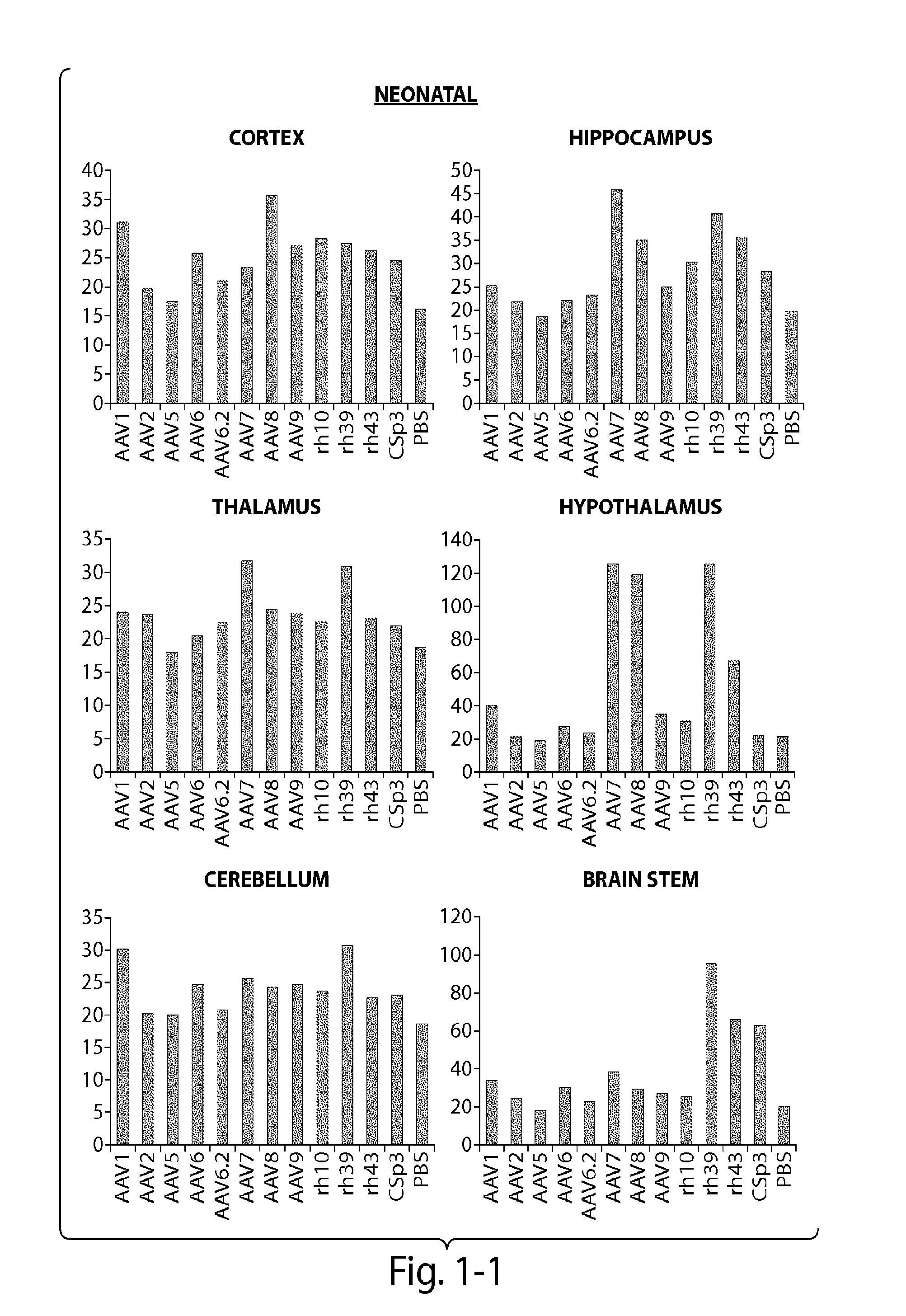CNS targeting aav vectors and methods of use thereof
a technology of aav and vector, applied in the field of recombinant adenoassociated viruses, can solve the problems of large obstacles in the application of aav-based gene therapy to treat cns disease, inability to achieve large-scale clinical trials, etc., to achieve stable and non-toxic gene transfer, wide-spread distribution, and wide-spread distribution
- Summary
- Abstract
- Description
- Claims
- Application Information
AI Technical Summary
Benefits of technology
Problems solved by technology
Method used
Image
Examples
example 1
Characterization of 12 AAV Vectors for Intravascular Delivery to Target CNS and Detarget Non-CNS Tissues by miRNA Regulation
[0121]The CNS gene transfer properties of 12 scAAVEGFP vectors of different serotypes, or natural variants were evaluated. RAAVs that cross the blood-brain-barrier (BBB) and target oligodendrocytes were discovered. Experiments were performed in neonatal mice (1 day old) and in adult mice (10 week old) (C57BL / 6). The following AAV serotypes were tested: AAV1, AAV2, AAV5, AAV6, AAV6.2, AAV7, AAV8, AAV9, rh.10 (also referred to herein as AAVrh.10), rh.39, rh.43, CSp3.
[0122]The recombinant AAV vectors expressed an enhanced GFP reporter gene under the CMV-enhanced chicken β-actin hybrid promoter and were produced by transient transfection in 293 cells. The neonatal day 1 pups were anesthetized with isoflurane. Then 100 μL of rAAV vectors (4×1011 GC per mouse) was injected to the pups via superfacial temporal vein under a dissection microscope. In adult mice, rAAV wa...
example 2
Construction and Evaluation of a Recombinant AAVrh.10 Vector to Treat CD
[0126]Canavan disease (CD) is an inherited neurodegenerative disorder caused by mutations in the aspartoacylase gene (ASPA), leading to accumulation of N-acetyl-aspartic acid (NAA) in oligodendrocytes with resultant spongy degeneration of white matter in the brain. An initial clinical study on rAAV2-based ASPA gene therapy for CD achieved very limited success. It is believed, without wishing to be bound by theory, that an effective CD gene therapy will transduce oligodendrocytes throughout the CNS.
[0127]A rAAV vector is constructed that comprises a promoter operably linked with a region encoding ASPA protein (SEQ ID NO: 13 or 15) as a gene therapy vector for CD. The construct employs CAG (chicken β-actin promoter with CMV enhancer) to drive the expression of ASPA having a coding sequence as set forth in SEQ ID NO: 14 or 16. The rAAV vector is package into rAAV particles using the triple transfection method. To e...
example 3
Therapeutic Efficacy and Safety Evaluation of an AAV Vector to Treat CD
[0128]The mouse model of CD is a C57BL / 6 derived ASPA gene KO strain. The homozygous KO animals present biochemical and neurological defects similar to those observed in CD patients. CD mice provide an animal model for evaluating gene therapy and other therapeutics for the treatment of CD. CD mice are used to study the efficacy and safety of the novel gene therapy strategies for the treatment of CD.
[0129]Experiment Design
[0130]To examine therapeutic efficacy and safety, scAAV vectors (e.g., AAV7, AAV8, CSp3 and AAV9) carrying an optimized ASPA expression cassette are investigated in a preclinical gene therapy trial of CD. The vectors include miRNA binding site(s) to inhibit ASPA expression in non-CNS tissues. Both postnatal day-1 and 3-month-old adult animals are treated with each vector at two doses, 1 and 3×1014 GC / kg by intravenous administration. For the neonatal CD mice, two litters of animals receive each v...
PUM
| Property | Measurement | Unit |
|---|---|---|
| Fraction | aaaaa | aaaaa |
| Fraction | aaaaa | aaaaa |
| Fraction | aaaaa | aaaaa |
Abstract
Description
Claims
Application Information
 Login to View More
Login to View More - R&D
- Intellectual Property
- Life Sciences
- Materials
- Tech Scout
- Unparalleled Data Quality
- Higher Quality Content
- 60% Fewer Hallucinations
Browse by: Latest US Patents, China's latest patents, Technical Efficacy Thesaurus, Application Domain, Technology Topic, Popular Technical Reports.
© 2025 PatSnap. All rights reserved.Legal|Privacy policy|Modern Slavery Act Transparency Statement|Sitemap|About US| Contact US: help@patsnap.com



